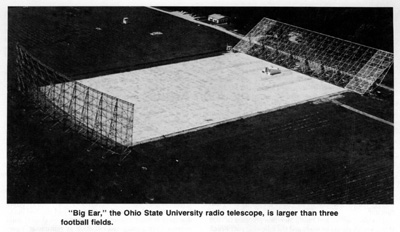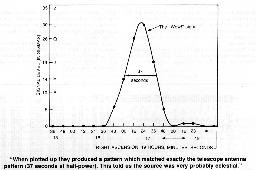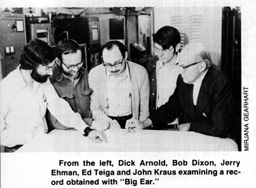Are we alone or are there other beings out there across the immense reaches of space who might be sending out radio signals we could hear? This question has long been a tantalizing one, and in recent years, with the construction of large radio telescopes, we now have the ability to try and find out.
Giuseppe Cocconi and Philip Morrison proposed in 1959 that a search should be made and the following year Frank Drake did just that in his famous Project Ozma but with negative results. Then in 1967 at the Cambridge University, England, radio observatory, Jocelyn Bell did discover strange pulsing signals from the sky which strongly suggested an extraterrestrial intelligent origin. However, these turned out to be emissions from a new kind of celestial object called a pulsar. (For details of these events see the January 1979 issue of COSMIC SEARCH).
Over the years many other searches have been made at many different radio observatories with negative results. But probably no search has been carried out more continuously for a longer time than the one started at the Ohio State-Ohio Wesleyan radio observatory in 1973. In this survey, which is still continuing, has any signal been detected which is suggestive of an extraterrestrial intelligent origin? Yes, and thereon hangs this tale.
 With National Science Foundation support and Ohio State University students doing the work, we began the construction of a large radio telescope near Delaware, Ohio, in 1956. Progress was slow but by 1963 the telescope was sufficiently far along to begin preliminary observations. Two years later we started a systematic survey of the entire sky accessible to our telescope that continued for 8 years resulting in our mapping and cataloging some 20,000 radio sources in the largest most complete survey anyone had made. Radio maps were a rather new thing at the time and because radio wavelengths are so much longer than
light the radio sky is quite different from the visual one.
With National Science Foundation support and Ohio State University students doing the work, we began the construction of a large radio telescope near Delaware, Ohio, in 1956. Progress was slow but by 1963 the telescope was sufficiently far along to begin preliminary observations. Two years later we started a systematic survey of the entire sky accessible to our telescope that continued for 8 years resulting in our mapping and cataloging some 20,000 radio sources in the largest most complete survey anyone had made. Radio maps were a rather new thing at the time and because radio wavelengths are so much longer than
light the radio sky is quite different from the visual one.
In 1964 when Robert S. "Bob" Dixon came to the Ohio State University as one of my graduate students, I started him on a mapping project which carried over into the big 8 year survey. One of Bob's early contributions was the development of a method for using antenna pattern fitting with a computer to produce cleaner, more reliable maps. This method, which Bob described in his doctoral dissertation in 1968, has become standard for improving the quality of telescope outputs.
In 1972 outside support for our mapping project was abruptly terminated due to a shift in funding priorities and we found ourselves in a strange situation. Our telescope was not the world's largest but there were very few larger. It also had one of the most sensitive 21 centimeter receivers in operation anywhere. Our big survey had resulted in the discovery of many objects belonging to a new class of radio sources having enhanced radiation at centimeter wavelengths and some of these—OH471 and OQ172—proved to be the most distant and most powerful sources ever found. Thus, we had a telescope of great capability but with no funds to do anything on a large scale. Would it be possible to do something at a very modest level?
Some years earlier, as a master's thesis project, William D. "Bill" Brundage* (*Now Chief Engineer of the Green Bank 91 meter telescope.) had built an 8-channel receiver for studying the hydrogen in the Andromeda galaxy. Bob Dixon now suggested that we utilize Bill's receiver to begin a "waterhole" search for narrow-band signals of extraterrestrial intelligent origin. His reasoning might be put this way: If we could discover what is out there essentially to the "edge" of the universe maybe our telescope could be useful in finding who might be out there. Bob didn't have to work very hard to persuade me, as the observatory director, to go along with the idea. So Bill's receiver was reconnected and by late 1973 we began our search on a routine basis. (More details of the above story are given in my book "Big Ear").
 Within a couple of years we had added a 50-channel receiver to supplement the old 8-channel one, and a dual-horn feed system, giving us two observations of a source on each transit instead of one and significantly improving the quality of the records. Bob Dixon had also connected a big computer on-line to process the data and print the output of all 50 channels in a simple-to-read format. Even though the observatory funding was now close to zero we were running the survey on an around-the-clock basis and continually making improvements in the equipment, in the data processing and in its analysis, but only because we had, in the meantime, acquired a lot of unpaid help. Many undergraduate engineering students designed and built new components for course credit, obtaining valuable practical experience to supplement the theory of the classroom. Then Richard Arnold volunteered to work an evening or so a week on equipment. Dick received his doctorate in electrical engineering from Washington University of St. Louis and was employed by the Bell Telephone Laboratories of Columbus. Jerry Ehman also volunteered to put in time on weekends. During the week he taught at Franklin University in Columbus. Jerry had been involved in our big sky survey some years earlier but had to leave when our funds were cut off. Now we were happy to have him back as a volunteer. Jerry earned his doctorate in radio astronomy at the University of Michigan. Even Bob Dixon was a volunteer because he was working almost full time elsewhere. So with very little money but with a number of talented and dedicated volunteers, a very large, well-equipped radio telescope was running essentially full time on a routine SETI program.
Within a couple of years we had added a 50-channel receiver to supplement the old 8-channel one, and a dual-horn feed system, giving us two observations of a source on each transit instead of one and significantly improving the quality of the records. Bob Dixon had also connected a big computer on-line to process the data and print the output of all 50 channels in a simple-to-read format. Even though the observatory funding was now close to zero we were running the survey on an around-the-clock basis and continually making improvements in the equipment, in the data processing and in its analysis, but only because we had, in the meantime, acquired a lot of unpaid help. Many undergraduate engineering students designed and built new components for course credit, obtaining valuable practical experience to supplement the theory of the classroom. Then Richard Arnold volunteered to work an evening or so a week on equipment. Dick received his doctorate in electrical engineering from Washington University of St. Louis and was employed by the Bell Telephone Laboratories of Columbus. Jerry Ehman also volunteered to put in time on weekends. During the week he taught at Franklin University in Columbus. Jerry had been involved in our big sky survey some years earlier but had to leave when our funds were cut off. Now we were happy to have him back as a volunteer. Jerry earned his doctorate in radio astronomy at the University of Michigan. Even Bob Dixon was a volunteer because he was working almost full time elsewhere. So with very little money but with a number of talented and dedicated volunteers, a very large, well-equipped radio telescope was running essentially full time on a routine SETI program.
Jerry Ehman gradually assumed major responsibility for the observing program and for analyzing the data output, a very considerable task. Bob Dixon and I occasionally assisted by scanning stacks of data and discussing results with Jerry.
In all of the thousands of hours of surveying since we started in 1973 we had never detected any signal that suggested an extraterrestrial intelligent origin. However, we had found a considerable number of narrow-band signals, perhaps 5 kilohertz or less in width, which we concluded were cold, isolated neutral hydrogen clouds. But then IT happened.
In mid-August (1977) Jerry Ehman showed Bob Dixon, Dick Arnold and me a section of new computer print-out with all of the characteristics that one might expect from an extraterrestrial beacon signal. Jerry's amazement was reflected by the words "Wow!" which he had written on the margin of the print-out.
The print-out format, which Bob Dixon had designed, consisted of 50 columns, one for each channel, with a single digit printed every 12 seconds indicating the signal level in that channel in units above the background level (the technical term for the unit used is one "standard deviation" or one "sigma"). A blank signified that the level was at zero. Any number above 4 or 5 might be considered as significant and probably not due to some random fluctuation. In order to accommodate levels above 9 with a single character, Bob arranged that the computer run through the alphabet with A for 10 through Z for 35.
 What Jerry had noted was a sequence of characters in Channel 2 running: 6, E, Q, U, J, 5. When plotted up they produced a pattern which matched exactly (within measurement error) the telescope antenna pattern. This told us that the source was very probably celestial, that is, fixed with respect to the star background and that it passed through the telescope beam with the earth's rotation. It was strong (30 sigmas or 30 times the background) and because it appeared in only one channel it was narrow-band (width 10 kilohertz or less). But even more significant, it was intermittent. A steady signal would have appeared two times on the record a few minutes apart as our telescope with its twin-beam scanned the sky.* (*The possibility that only one horn was functioning at the time can be ruled out because the two horns are balanced and, if one were
out, the system would have been inoperative.) So it was an "on and off" signal! Was it intended for us?
What Jerry had noted was a sequence of characters in Channel 2 running: 6, E, Q, U, J, 5. When plotted up they produced a pattern which matched exactly (within measurement error) the telescope antenna pattern. This told us that the source was very probably celestial, that is, fixed with respect to the star background and that it passed through the telescope beam with the earth's rotation. It was strong (30 sigmas or 30 times the background) and because it appeared in only one channel it was narrow-band (width 10 kilohertz or less). But even more significant, it was intermittent. A steady signal would have appeared two times on the record a few minutes apart as our telescope with its twin-beam scanned the sky.* (*The possibility that only one horn was functioning at the time can be ruled out because the two horns are balanced and, if one were
out, the system would have been inoperative.) So it was an "on and off" signal! Was it intended for us?
Bob, Jerry, Dick and I had urgent discussions about its significance. We soon were referring to it as the "Wow!" signal. We decided that we should continue to scan the same region of sky on the chance that the signal might reappear. But it never did, and after weeks of patient listening we moved on with our survey to other parts of the sky.
We checked star catalogs for any sun-like stars in the area and found none. We consulted ephemerides and made inquiries to see if any space probes could have been in the area and found none. The region is near the galactic plane and not too far from the center of the galaxy. Although it is not far south of the ecliptic (the plane near which most solar system objects are found and toward which a probe might be travelling) the moon, the major planets and even the four largest minor ones were all far removed in position and the Voyagers had not yet been launched. So we drew a complete blank.
Since then many improvements have been incorporated in our equipment so that now we could tell a great deal more about any signal. But we can't turn the clock back; we have to settle for the data we have which, nevertheless, is considerable and is impressive. The signal we got is by far the most suggestive of an extraterrestrial intelligent origin of anything we have detected in 6 years of searching.
What was it?
(1) It could have been a signal from an earth-launched space probe of which we are unaware. This is the most likely possibility. A signal from one of our distant space probes would be an "extraterrestrial intelligent signal" but it would be man-made.
(2) It could have been a signal from an extraterrestrial civilization which was turning on and off (or sweeping by) and we just happened to catch it for one full antenna pattern. But since it has not returned, so we could study it further, this is pure speculation. (If a pulsar had only been detected once on one fleeting transit, no one could have concluded anything from it). So until the signal comes back again and again for further study we can only wait and wonder.
Notes: (1) We were searching deeply enough for us to assume that there was always, on the average, a candidate star (with intelligent civilization) in the antenna beam. Hence, as in our earlier sky mapping survey, we were scanning the whole sky systematically and uniformly without stopping to examine any point in the sky more than any other unless something like the "Wow" signal came along.
(2) As of August 1977 the computer print-out had not yet been corrected for horn squints in both right ascension and declination so that the apparent position on the print-out is not the true value.
(3) Operation continues with the small group of dedicated volunteers.

 John Kraus is the Taine G. McDougal Professor of Electrical Engineering and Astronomy at the Ohio State University and the Director-Founder of the Ohio State-Ohio Wesleyan Radio Observatory where the O.S.U. radio telescope is situated. Born in Ann Arbor, Michigan, in 1910, he received degrees through the doctorate from the University of Michigan and, prior to joining the O.S.U. faculty in 1946, was employed by the U.S. Navy and Harvard University. Author of widely-used textbooks on antennas, electromagnetic theory and radio astronomy, and of hundreds of articles, he is the inventor of many types of antennas. He is the recipient of the Sullivant Medal of the Ohio State University and is a member of the National Academy of Engineering. Kraus is Editor of COSMIC SEARCH.
John Kraus is the Taine G. McDougal Professor of Electrical Engineering and Astronomy at the Ohio State University and the Director-Founder of the Ohio State-Ohio Wesleyan Radio Observatory where the O.S.U. radio telescope is situated. Born in Ann Arbor, Michigan, in 1910, he received degrees through the doctorate from the University of Michigan and, prior to joining the O.S.U. faculty in 1946, was employed by the U.S. Navy and Harvard University. Author of widely-used textbooks on antennas, electromagnetic theory and radio astronomy, and of hundreds of articles, he is the inventor of many types of antennas. He is the recipient of the Sullivant Medal of the Ohio State University and is a member of the National Academy of Engineering. Kraus is Editor of COSMIC SEARCH.
![[NAAPO Logo]](../../Images/NAAPOsm.jpg)
![[NAAPO Logo]](../../Images/NAAPOsm.jpg)